When we think about Bali, images of stunning beaches, lush rice terraces, and vibrant culture often come to mind. However, Bali’s rich culinary heritage, especially its traditional desserts, remains a hidden treasure waiting to be discovered. Beyond the famous tropical fruits and exotic drinks, Balinese desserts offer a unique blend of flavors, textures, and stories that reflect the island’s cultural richness and natural bounty.
If you’re a food lover or a curious traveler eager to explore authentic tastes, this article takes you on a delicious journey through The Best Traditional Balinese Desserts You’ve Never Tried.
From sweet sticky rice treats to fragrant coconut delights, these desserts are sure to awaken your palate and deepen your appreciation for Bali’s culinary artistry.
Dadar Gulung – The Green Pancake Roll 🍃🥞
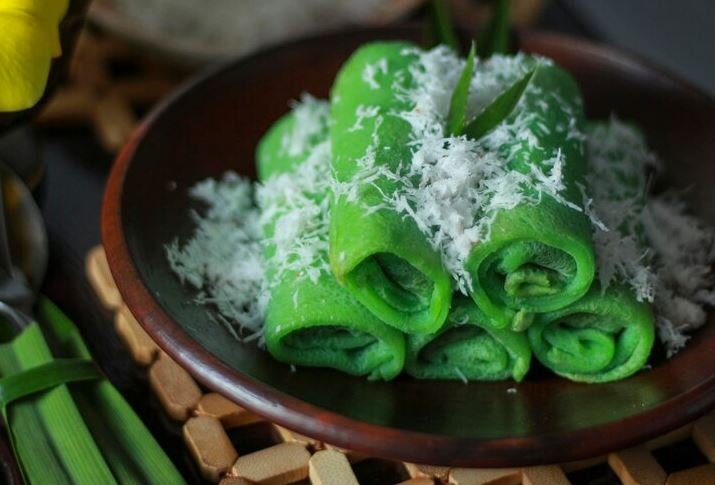
Dadar Gulung is a beloved Balinese and Indonesian dessert that looks simple but is packed with flavor and tradition. This dessert features a thin, green pancake made from rice flour and pandan leaves, rolled with a luscious filling of grated coconut mixed with palm sugar.
The pandan gives the pancake its vibrant green color and a sweet, floral aroma, while the filling balances sweetness with a slightly chewy texture. This treat is often enjoyed as a snack or dessert, perfect with a cup of Balinese coffee.
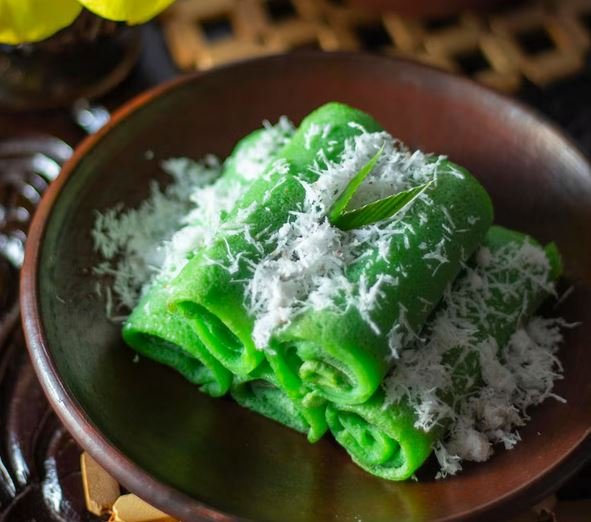
Why It’s Special:
Dadar Gulung reflects Bali’s use of local ingredients like pandan and palm sugar, showcasing the island’s natural flavors in a simple yet elegant way.
| About Dadar Gulung (The Green Pancake Roll) & Where to Buy in Bali |
| Name: Dadar Gulung (The Green Pancake Roll) |
| Color: Green, naturally colored from pandan or suji leaves |
| Filling: Grated coconut mixed with palm sugar (called unti) |
| Taste: Sweet, slightly salty, fragrant from pandan |
| Texture: Soft pancake exterior with chewy, sweet coconut filling |
| Price: Very affordable, around Rp2,000–Rp5,000 per roll |
| Best for: Light snack, breakfast, or tea-time treat |
| Origin: Traditional snack popular in Java and Bali |
| Where to Buy in Bali: |
- Pasar Badung, Denpasar – Traditional market with wide variety
- Pasar Kreneng, Denpasar – Many local snack (jajan pasar) stalls
- Bali Buda Cafe & Bakery – Offers healthier, organic versions
- Seniman Cafe, Ubud – Occasionally offers local snacks
- Ubud Market (Pasar Ubud) – Street vendors sell it fresh
- Warung Nasi Campur (local eateries) – Often included as dessert
- Krisna or Agung Bali Souvenir Shops – Sometimes sold pre-packed
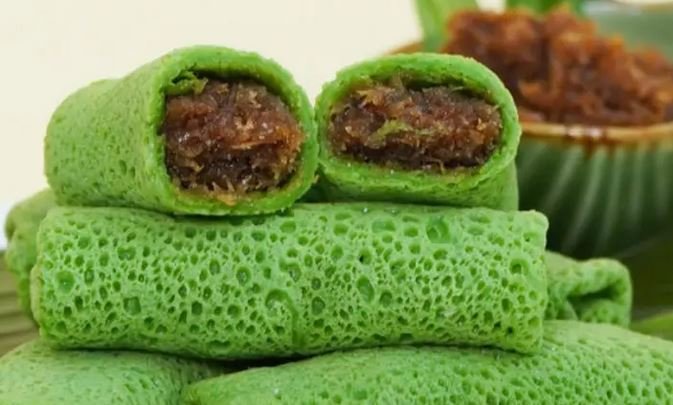
How to Make Dadar Gulung – The Green Pancake Roll
Ingredients:
For the pancake batter:
- 150 grams all-purpose flour
- 2 eggs
- 300 ml coconut milk
- 1/2 teaspoon salt
- 1 tablespoon sugar
- 1/2 teaspoon pandan extract or 2-3 pandan leaves (blended and strained for natural green color)
For the filling (unti):
- 200 grams grated coconut (fresh or frozen, unsweetened)
- 150 grams palm sugar (gula merah), finely chopped or grated
- 2 tablespoons water
- 1 pandan leaf (optional)
Instructions:
1. Prepare the filling (unti):
- In a pan, combine palm sugar, water, and pandan leaf.
- Cook over medium heat until the sugar melts and forms a syrup.
- Add grated coconut, stir continuously to combine well and cook until the coconut is coated and slightly dry but still moist.
- Remove pandan leaf and set aside to cool.
2. Make the pancake batter:
- In a mixing bowl, whisk eggs, sugar, and salt until combined.
- Gradually add flour, mixing until smooth.
- Slowly pour in coconut milk while stirring to get a thin, smooth batter.
- Add pandan extract or strained pandan juice for green color and aroma.
3. Cook the pancakes:
- Heat a non-stick skillet or crepe pan over medium-low heat.
- Lightly grease the pan with a little oil.
- Pour a small ladle of batter and swirl the pan to spread it thinly and evenly.
- Cook for about 1-2 minutes or until the edges start to lift and the pancake is cooked but still soft.
- Remove from pan and place on a plate.
4. Assemble the Dadar Gulung:
- Place 1-2 tablespoons of the coconut filling near the edge of the pancake.
- Roll it up tightly to form a neat roll (like a crepe roll).
- Repeat until all batter and filling are used.
Serving:
Serve Dadar Gulung at room temperature or slightly chilled as a sweet snack or dessert.
Klepon – Sweet Rice Cake Balls with a Surprise 🎉🍬
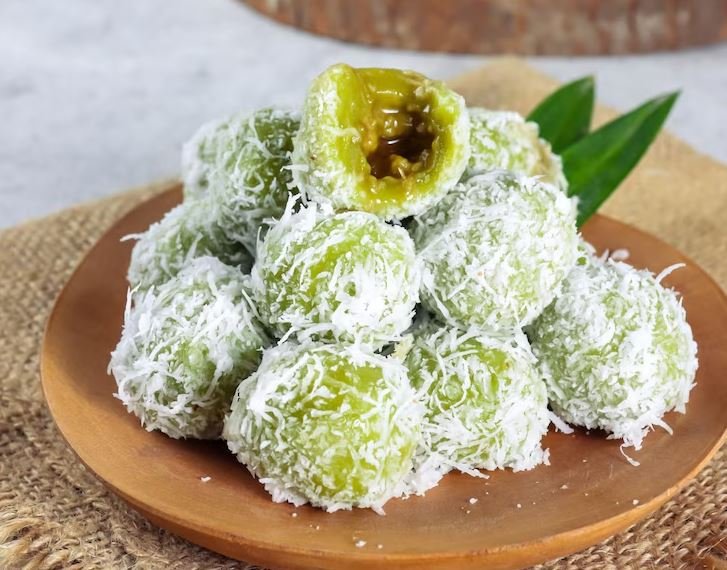
Klepon are delightful, chewy rice cake balls filled with molten palm sugar and coated in freshly grated coconut. When you bite into one, the palm sugar inside bursts out, creating a sweet, sticky surprise.
Made from glutinous rice flour and colored with pandan extract, klepon is a festive dessert often found at traditional markets and ceremonies. It’s an irresistible snack that perfectly combines texture and sweetness.
Cultural Note:
Klepon is commonly offered during Balinese religious ceremonies as a symbol of sweetness and prosperity.
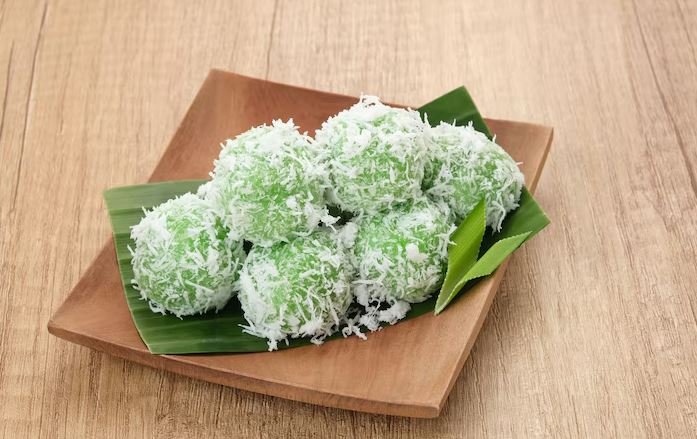
📋 Information about Klepon – Sweet Rice Cake Balls with a Surprise
| Description |
| Highlight: Klepon is a traditional Indonesian sweet treat shaped into small green balls made from glutinous rice flour. It is filled with melted palm sugar and coated with freshly grated coconut. The texture is chewy with a delightful burst of sweetness inside. |
| Main Ingredients: Glutinous rice flour, palm sugar, grated coconut, pandan or screwpine leaf extract (for natural green color and aroma). |
| Region of Origin: Widely known throughout Indonesia, especially in Java and Bali. |
| Unique Features: Natural green color, chewy outer layer, sweet molten center, and a coating of fresh grated coconut. |
| Best Time to Enjoy: Commonly eaten as a morning or afternoon snack; often sold at traditional markets. |
| Where to Buy: |
- Traditional markets in Indonesia
- Local snack or “kue basah” stores
- Souvenir or specialty food shops
- Select Indonesian restaurants abroad
- Homemade
Perfect For: Sweet lovers, family gatherings, traditional events, or as a treat to break the fast during Ramadan.
Modern Variants: Some modern versions use different colors, chocolate or cheese fillings, and creative toppings.
Serving Tip: Eat it in one bite to fully enjoy the molten palm sugar center without it spilling out.
Price: Very affordable, around Rp2,000–Rp5,000
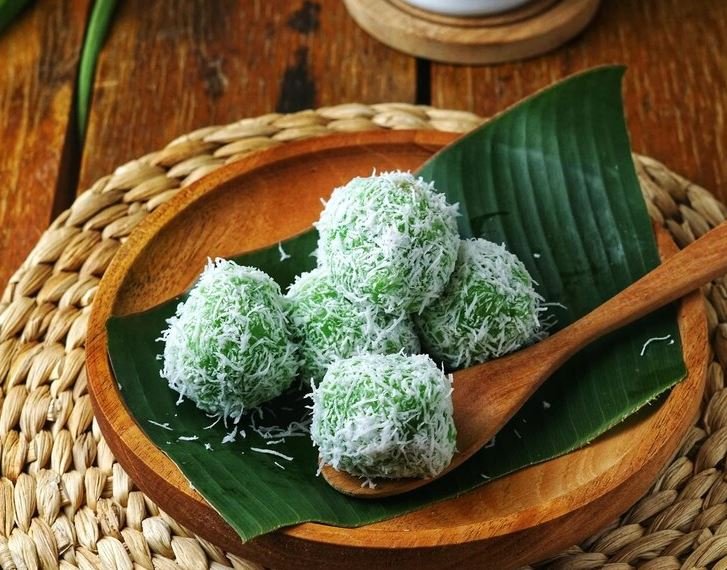
How to Make Klepon – Sweet Rice Cake Balls with a Surprise
Ingredients:
- 200 grams glutinous rice flour
- 150 ml water (or more, as needed)
- 3-4 drops pandan extract (or use pandan juice for natural green color)
- 100 grams palm sugar (gula merah), chopped into small pieces
- 100 grams fresh grated coconut (preferably young coconut), lightly salted
- A pinch of salt
- Water for boiling
Instructions:
1. Prepare the dough:
- In a mixing bowl, combine the glutinous rice flour with pandan extract.
- Gradually add water little by little while kneading until you get a smooth, pliable dough that is not too sticky and easy to shape.
2. Shape the Klepon:
- Take a small piece of dough (about the size of a walnut).
- Flatten it gently in your palm, place a small piece of palm sugar in the center.
- Carefully fold and seal the dough around the sugar, rolling it into a smooth ball.
- Repeat until all dough and palm sugar pieces are used.
3. Cook the Klepon:
- Bring a pot of water to a boil.
- Drop the klepon balls carefully into boiling water.
- When they float to the surface, cook them for another 1-2 minutes to ensure the dough is cooked through.
- Remove with a slotted spoon and drain.
4. Coat with grated coconut:
- Toss the cooked klepon balls in the lightly salted grated coconut until well coated.
Serving:
Serve Klepon at room temperature as a sweet, chewy snack with a liquid palm sugar surprise inside.
Bubur Injin – Black Rice Porridge Bowl 🍚🖤
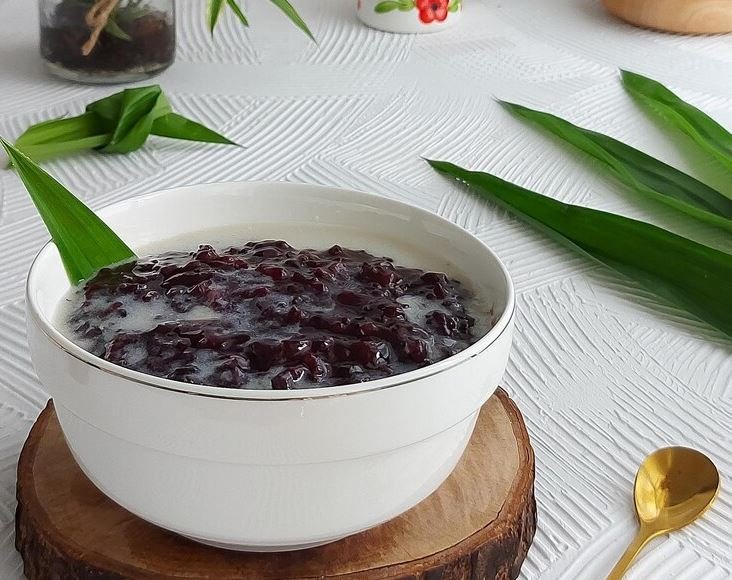
Bubur Injin is a comforting Balinese dessert made from black glutinous rice cooked slowly into a thick, sweet porridge. This dessert is typically flavored with coconut milk and palm sugar, resulting in a creamy and fragrant bowl of goodness.
Black rice is known for its nutritional benefits and unique nutty flavor, making Bubur Injin not only tasty but also healthy.
Interesting Fact:
In Bali, black rice was once reserved for royalty, making Bubur Injin a dessert fit for kings and queens.
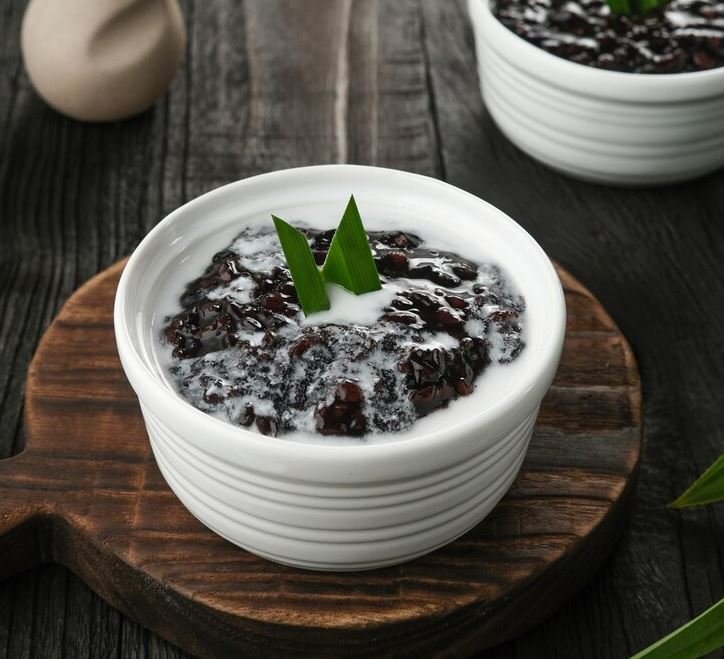
| About Bubur Injin – Black Rice Porridge Bowl |
| Highlight: Bubur Injin is a traditional Indonesian sweet porridge made from black glutinous rice. It’s known for its deep purple-black color, chewy texture, and naturally sweet flavor, often served with coconut milk and palm sugar syrup. |
| Main Ingredients: Black glutinous rice, coconut milk, palm sugar, pandan leaves (for aroma), salt. |
| Taste: Sweet and creamy with a slightly chewy texture from the black rice. |
| Texture: Thick, sticky, and chewy porridge with smooth coconut milk topping. |
| Origin: Popular traditional dessert/snack across Java and Bali. |
| Best Time to Eat: As a dessert or snack, especially in the afternoon or evening. |
| Price Range: Around Rp5,000 to Rp15,000 per serving (depending on location and vendor). |
| Where to Buy: |
- Traditional markets in Java and Bali
- Street food vendors selling Indonesian desserts
- Local warungs (small eateries)
- Some Indonesian restaurants abroad, especially those specializing in traditional cuisine
Serving Suggestion: Serve warm or at room temperature, topped with coconut milk and a drizzle of palm sugar syrup for extra sweetness.
🍚 How to Make Bubur Injin – Black Rice Porridge Bowl
Ingredients:
For the porridge:
- 200 grams black glutinous rice (also called black sticky rice)
- 1 liter water (plus more as needed)
- 1 pandan leaf, tied into a knot (optional)
- 1/4 teaspoon salt
- 100 grams palm sugar or brown sugar (adjust to taste)
For the coconut sauce (santan):
- 200 ml coconut milk
- 1/4 teaspoon salt
- 1 pandan leaf (optional)
Instructions:
1. Soak the rice:
- Rinse black glutinous rice thoroughly.
- Soak in water for at least 4–6 hours or overnight to shorten cooking time.
2. Cook the rice porridge:
- Drain the soaked rice and place it in a pot with 1 liter of water and the pandan leaf.
- Bring to a boil, then reduce to a simmer.
- Cook uncovered for about 45 minutes to 1 hour, stirring occasionally, until the rice is soft and the mixture is thickened.
- Add more water if it gets too thick before the rice is tender.
- Once soft, add salt and palm sugar. Stir until the sugar dissolves and adjust sweetness as desired.
- Remove from heat and discard the pandan leaf.
3. Make the coconut sauce:
- In a small saucepan, combine coconut milk, salt, and pandan leaf.
- Heat over low flame, stirring constantly.
- Do not let it boil—just warm it gently until aromatic. Remove pandan leaf.
4. Serve:
- Spoon the black rice porridge into serving bowls.
- Drizzle generously with the warm coconut sauce.
- Can be served warm or chilled.
✅ Tips:
- For extra flavor, use a mix of palm sugar and brown sugar.
- Keep stirring the coconut milk to prevent curdling.
- Add sliced banana or jackfruit for a fruity twist.
Es Campur – Refreshing Mixed Ice Dessert ❄️🍧
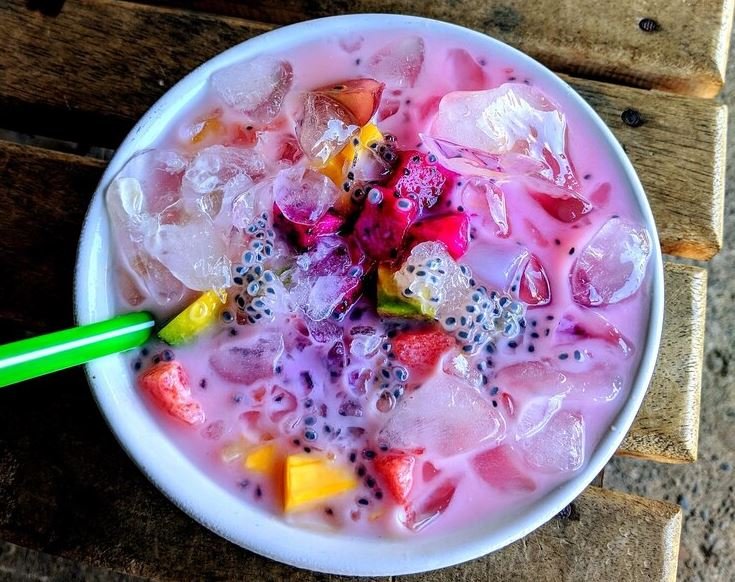
Es Campur, meaning “mixed ice,” is a popular Balinese dessert perfect for tropical heat. It combines shaved ice with a colorful array of ingredients such as jelly cubes, sweetened condensed milk, fruit, grass jelly, and syrup.
This dessert is both refreshing and satisfying, offering a cool contrast to Bali’s warm climate and a delightful mix of textures and flavors.
Why Try It:
Es Campur is a street food favorite and an instant mood lifter with its vibrant appearance and sweet taste.
| About Es Campur – Refreshing Mixed Ice Dessert |
| Highlight: Es Campur is a popular Indonesian iced dessert featuring a colorful mix of ingredients such as shaved ice, sweet syrups, fruits, jelly, grass jelly, and sometimes sweetened condensed milk. It’s very refreshing and perfect for hot weather. |
| Main Ingredients: Shaved ice, coconut milk, palm sugar syrup or sweet syrup, assorted fruits (like jackfruit, avocado, mango), grass jelly, nata de coco, agar jelly, sweetened condensed milk. |
| Taste: Sweet, creamy, fruity, and refreshing with a variety of textures from chewy jelly to crunchy nuts (optional). |
| Texture: Combination of crunchy, chewy, and icy textures in one bowl. |
| Origin: Widely enjoyed throughout Indonesia as a traditional street food dessert. |
| Best Time to Eat: Ideal for hot days as a refreshing snack or dessert. |
| Price Range: Approximately Rp8,000 to Rp20,000 per serving depending on ingredients and location. |
| Where to Buy: |
- Street food vendors and traditional markets across Indonesia
- Local cafes and warungs (small eateries)
- Food courts in shopping malls
- Some Indonesian restaurants overseas |
Serving Suggestion: Serve chilled with plenty of shaved ice and mix well before eating to enjoy all flavors combined.
🍧 How to Make Es Campur – Refreshing Mixed Ice Dessert
🛒 Ingredients (can be customized based on availability):
Base ingredients:
- Shaved ice or crushed ice
- Sweetened condensed milk (optional, for creaminess)
- Simple syrup or cocopandan syrup
- Coconut milk or evaporated milk (optional)
Common mix-ins (choose 5–7):
- Young coconut meat (scraped)
- Avocado (cubed or scooped)
- Jackfruit (thinly sliced)
- Grass jelly (cincau), cut into cubes
- Nata de coco
- Tapioca pearls (boba or sago)
- Agar-agar jelly (colored, cubed)
- Fermented cassava (tape)
- Sweet corn (cooked)
- Kolang-kaling (sugar palm fruit)
🥄 Instructions:
1. Prepare the ingredients:
- Cut and chill all fruit, jelly, and toppings.
- Boil tapioca pearls or sago if using.
- Make simple syrup (1:1 sugar and water, boiled and cooled) or use cocopandan syrup.
2. Assemble in serving bowls or tall glasses:
- Add a generous spoonful of each mix-in.
- Top with a mound of shaved ice or crushed ice.
3. Add sweeteners and creaminess:
- Pour over 1–2 tablespoons of syrup (adjust to taste).
- Drizzle with sweetened condensed milk and/or a splash of coconut milk for a creamy touch.
4. Serve immediately:
- Mix well before eating to enjoy the blend of textures and flavors.
💡 Tips:
- Adjust sweetness to taste.
- Use a mix of soft, crunchy, chewy, and juicy ingredients for best texture contrast.
- For a vegan version: skip condensed milk and use coconut milk or plant-based alternatives.
Jaja Laklak – Coconut Pancakes with Palm Sugar Syrup 🥞🍯
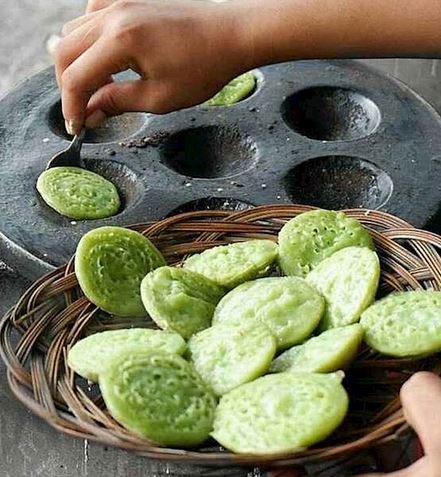
Jaja Laklak is a traditional Balinese snack made from rice flour and coconut milk, steamed into small, thick pancakes. These pancakes are then topped with freshly grated coconut and drizzled with a rich palm sugar syrup.
The slightly chewy texture combined with the sweet syrup and fragrant coconut makes Jaja Laklak a perfect combination of tastes and textures.
| About Jaja Laklak – Coconut Pancakes with Palm Sugar Syrup |
| Highlight: Jaja Laklak is a traditional Balinese snack made of small, soft coconut pancakes topped with melted palm sugar syrup. The pancakes have a slightly chewy texture with a rich coconut flavor, complemented by the sweet and aromatic palm sugar. |
| Main Ingredients: Rice flour, grated coconut, coconut milk, palm sugar syrup, pandan leaves (for aroma), salt. |
| Taste: Sweet, rich coconut flavor with caramel-like palm sugar sweetness. |
| Texture: Soft and chewy pancake base with sticky, syrupy topping. |
| Origin: Traditional Balinese snack, often found in markets and ceremonies. |
| Best Time to Eat: Perfect as a breakfast item, afternoon snack, or dessert. |
| Price Range: Usually affordable, around Rp3,000 to Rp10,000 per serving depending on vendor and location. |
| Where to Buy: |
- Traditional markets in Bali, especially Pasar Badung and Pasar Kumbasari
- Street food stalls around Ubud and Denpasar
- Local warungs (small eateries) and food stalls
- Sometimes available at Balinese cultural events and festivals |
Serving Suggestion: Serve warm with generous drizzle of palm sugar syrup on top. Best enjoyed fresh.
🥞 How to Make Jaja Laklak – Coconut Pancakes with Palm Sugar Syrup
🛒 Ingredients:
For the pancakes:
- 150 grams rice flour
- 1/2 teaspoon baking powder
- 1/4 teaspoon salt
- 300 ml coconut milk
- 2–3 drops pandan extract or pandan juice (for green color and aroma)
For the palm sugar syrup:
- 150 grams palm sugar (gula merah), chopped
- 100 ml water
- 1 pandan leaf (optional)
- A pinch of salt
Topping:
- Fresh grated coconut, lightly salted
🥄 Instructions:
1. Make the pancake batter:
- In a bowl, combine rice flour, baking powder, and salt.
- Slowly pour in coconut milk while stirring to create a smooth batter.
- Add pandan extract or pandan juice for color and aroma.
- Let the batter rest for 15–30 minutes.
2. Cook the pancakes:
- Heat a small non-stick or traditional clay pan over medium heat.
- Lightly grease the surface.
- Pour in a small ladle of batter (pancakes are usually thick and round).
- Cover the pan and cook for 3–5 minutes, or until bubbles appear and the top is fully cooked (you don’t need to flip them).
- Repeat with remaining batter.
3. Make the palm sugar syrup:
- In a small pot, combine chopped palm sugar, water, pandan leaf, and a pinch of salt.
- Bring to a gentle boil and simmer until the sugar is fully dissolved and slightly thickened.
- Strain if needed to remove impurities or pandan leaf.
4. Assemble and serve:
- Place pancakes on a plate.
- Sprinkle with freshly grated coconut.
- Drizzle with warm palm sugar syrup.
✅ Tips:
- Serve warm for best flavor.
- Use young coconut for softer, juicier grated topping.
- You can also make mini versions for bite-sized snacks!
Dadar Kuning – Yellow Coconut Pancakes 🌼🥥
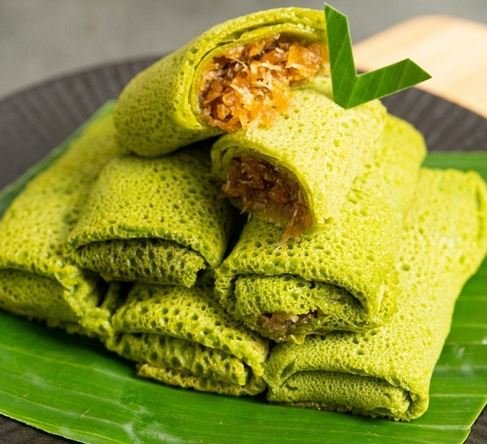
Dadar Kuning is similar to Dadar Gulung but uses turmeric to give the pancakes a sunny yellow hue instead of pandan’s green. Filled with sweet grated coconut mixed with palm sugar, these yellow pancakes are both visually striking and delicious.
Turmeric adds a subtle earthy flavor, making Dadar Kuning a unique twist on the classic coconut pancake.
| About Dadar Kuning – Yellow Coconut Pancakes |
| Highlight: Dadar Kuning is a traditional Indonesian pancake made with a yellow-colored batter, usually from turmeric or egg yolk, filled with sweet grated coconut cooked in palm sugar. It’s similar to the more common green Dadar Gulung but has a distinct golden color and flavor. |
| Main Ingredients: Wheat flour or rice flour, turmeric or egg yolk (for yellow color), grated coconut, palm sugar (unti), coconut milk, salt. |
| Taste: Sweet with rich coconut flavor, slightly earthy and warm from turmeric. |
| Texture: Soft and thin pancake with chewy sweet coconut filling inside. |
| Origin: Popular in various regions of Indonesia, especially Java and Bali. |
| Best Time to Eat: Great as a snack, breakfast, or dessert. |
| Price Range: Around Rp3,000 to Rp8,000 per piece depending on location. |
| Where to Buy: |
- Traditional markets across Indonesia
- Local warungs and street vendors
- Indonesian specialty snack shops and food stalls |
Serving Suggestion: Serve at room temperature or slightly warm for best flavor.
Pisang Rai – Steamed Banana Dumplings 🍌🥟
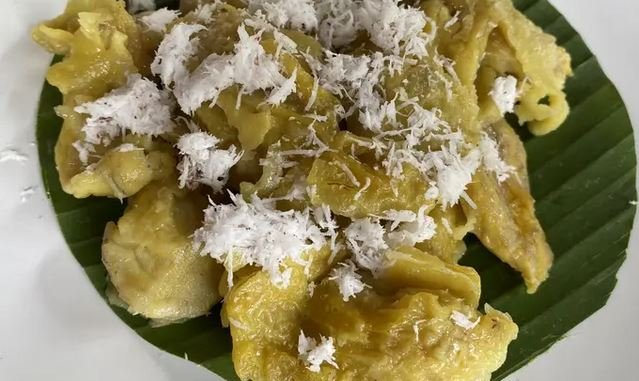
| About Pisang Rai – Steamed Banana Dumplings |
| Highlight: Pisang Rai is a traditional Balinese snack made from ripe bananas coated in glutinous rice flour dough, steamed until soft, and often coated with grated coconut. It’s sweet, soft, and fragrant, enjoyed as a comforting treat. |
| Main Ingredients: Ripe bananas, glutinous rice flour, grated coconut, palm sugar (optional), salt, pandan leaf (for aroma). |
| Taste: Naturally sweet from banana, with a mild coconut flavor and soft, chewy texture. |
| Texture: Soft banana center wrapped in chewy steamed dough, coated with fresh grated coconut. |
| Origin: Traditional snack from Bali, popular in local markets and ceremonies. |
| Best Time to Eat: Perfect as a snack or dessert anytime. |
| Price Range: Approximately Rp3,000 to Rp10,000 per serving depending on vendor. |
| Where to Buy: |
- Traditional markets in Bali, like Pasar Badung and Ubud Market
- Street vendors and local warungs (small eateries)
- Balinese cultural events and festivals |
| Serving Suggestion: Serve warm or at room temperature, optionally with a drizzle of palm sugar syrup for extra sweetness. |
Pisang Rai is a sweet snack made from steamed banana wrapped in glutinous rice flour dough. These dumplings are served with grated coconut and a drizzle of palm sugar syrup, offering a warm, comforting dessert with a perfect balance of sweetness.
Banana adds natural sweetness and softness, making Pisang Rai a beloved street food and family favorite.
Serabi Bali – Traditional Balinese Pancakes 🥞🔥
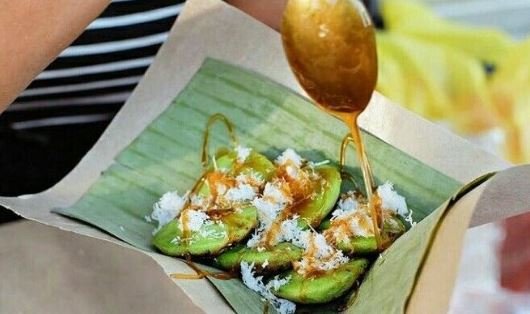
Serabi Bali are small, round pancakes made from rice flour and coconut milk, often cooked over charcoal for a slight smoky flavor. They can be served plain or topped with palm sugar syrup, banana slices, or even savory toppings like shredded chicken.
The combination of crispy edges and soft, creamy centers makes Serabi Bali a versatile dessert or snack.
| About Serabi Bali – Traditional Balinese Pancakes |
| Highlight: Serabi Bali are traditional Balinese pancakes made from rice flour and coconut milk, cooked on a small clay pan to create a slightly crispy edge with a soft, fluffy center. They are usually served with palm sugar syrup or coconut sugar sauce. |
| Main Ingredients: Rice flour, coconut milk, sugar, coconut sugar or palm sugar syrup, salt, pandan leaves (for aroma). |
| Taste: Sweet, creamy, and aromatic with a rich coconut flavor and caramelized sugar notes. |
| Texture: Soft and fluffy in the center with slightly crispy edges. |
| Origin: Traditional Balinese snack commonly found in Bali markets and street stalls. |
| Best Time to Eat: Ideal as breakfast, snack, or dessert. |
| Price Range: Around Rp3,000 to Rp10,000 per piece depending on vendor and location. |
| Where to Buy: |
- Traditional markets and street food stalls in Bali (e.g., Pasar Badung, Ubud Market)
- Local warungs and food stalls around Bali
- Balinese cultural festivals and events |
Serving Suggestion: Serve warm with a drizzle of palm sugar syrup or coconut sugar sauce on top for best flavor.
🥞 How to Make Serabi Bali – Traditional Balinese Pancakes
🛒 Ingredients:
For the pancake batter:
- 150 grams rice flour
- 1 teaspoon instant yeast
- 1 tablespoon sugar
- 1/4 teaspoon salt
- 200 ml coconut milk (warm, not hot)
- 1–2 drops pandan extract or pandan juice (optional, for color and aroma)
For the coconut sugar sauce (kuah kental gula merah):
- 150 grams palm sugar (gula merah), finely chopped
- 100 ml water
- 1 pandan leaf
- A pinch of salt
- 50 ml thick coconut milk (added at the end for creaminess)
🥄 Instructions:
1. Prepare the batter:
- In a bowl, mix rice flour, sugar, and salt.
- Dissolve the yeast in warm coconut milk, then add to the flour mixture.
- Stir until smooth and let the batter rest for 30–60 minutes to rise and bubble.
- Add pandan extract if using for a green version.
2. Cook the Serabi:
- Heat a small non-stick or traditional clay serabi pan over medium heat.
- Lightly grease it with a bit of oil.
- Pour a small ladleful of batter into the pan.
- Cover and cook for about 4–6 minutes until the surface is set and the bottom is lightly browned.
- Do not flip.
- Repeat with remaining batter.
3. Make the coconut sugar sauce:
- In a saucepan, boil palm sugar, water, pandan leaf, and salt until sugar dissolves.
- Remove the pandan leaf.
- Lower the heat and add thick coconut milk, stir continuously until slightly thickened.
- Do not boil after adding coconut milk to prevent curdling.
4. Serve:
- Serve the warm Serabi pancakes with a generous drizzle of the coconut sugar sauce on top or on the side.
✅ Tips:
- Use a clay serabi pan for authentic crispy edges.
- You can make mini or large versions depending on your pan.
- Let the sauce cool slightly to thicken before serving.
Jaja Bantal – Pillowy Sweet Rice Cakes 🎈🍬
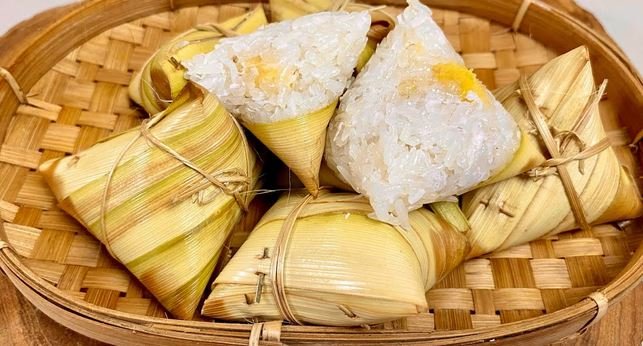
Jaja Bantal, meaning “pillow cake,” are soft, spongy rice cakes steamed and then topped with grated coconut and palm sugar syrup. Their light, airy texture and natural sweetness make them an irresistible treat.
These cakes are often shaped into small pillows, symbolizing comfort and warmth in Balinese culture.
| About Jaja Bantal – Pillowy Sweet Rice Cakes |
| Highlight: Jaja Bantal is a traditional Indonesian snack made from steamed glutinous rice flour dough, shaped into soft, pillow-like cakes. They have a chewy texture and are often served plain or with a sprinkle of grated coconut or palm sugar syrup. |
| Main Ingredients: Glutinous rice flour, coconut milk, sugar, salt, grated coconut (optional), palm sugar syrup (optional). |
| Taste: Mildly sweet with a rich coconut aroma and soft, chewy texture. |
| Texture: Soft, pillowy, and chewy. |
| Origin: Popular traditional snack across Indonesia, often found in markets and during ceremonies. |
| Best Time to Eat: Great as a snack or dessert anytime. |
| Price Range: Typically priced around Rp3,000 to Rp8,000 per piece or serving. |
| Where to Buy: |
- Traditional markets throughout Indonesia
- Local street food vendors and warungs
- Specialty Indonesian snack shops |
Serving Suggestion: Serve at room temperature or slightly warm, optionally with grated coconut or palm sugar syrup on top.
🎋 How to Make Jaja Bantal – Pillowy Sweet Rice Cakes
🛒 Ingredients:
For the filling:
- 150 grams sticky (glutinous) rice
- 100 grams grated coconut (fresh or thawed)
- 75 grams palm sugar, chopped or grated
- A pinch of salt
- 1 pandan leaf (optional, tied into a knot)
- Water for soaking and cooking
For wrapping:
- Banana leaves (wilted/softened in hot water or over flame)
- Small kitchen string or toothpicks (to secure the wraps)
🥣 Instructions:
1. Soak the sticky rice:
- Wash and soak the glutinous rice in water for about 3–4 hours or overnight.
2. Prepare the filling:
- In a saucepan, combine soaked sticky rice (drained), grated coconut, palm sugar, salt, and pandan leaf.
- Add a little water (about 100–150 ml) and cook over low heat.
- Stir frequently until the mixture thickens, the sugar melts, and the rice is about 70% cooked (still slightly firm).
- Let the mixture cool.
3. Prepare the banana leaves:
- Cut into 15×20 cm rectangles.
- Soften them by steaming or briefly heating over a stove flame so they’re pliable.
- Wipe clean and let dry.
4. Assemble the Jaja Bantal:
- Place 2–3 tablespoons of the filling in the center of the banana leaf.
- Fold into a tight rectangular or pillow-like shape.
- Secure with kitchen string or toothpicks.
5. Steam:
- Steam the wrapped cakes over medium heat for about 30–40 minutes until the rice is fully cooked and tender.
6. Serve:
- Let cool slightly before serving. Jaja Bantal is typically eaten warm or at room temperature.
✅ Tips:
- Can be stored in the fridge for 2–3 days and reheated by steaming.
- Banana leaves give the cake a fragrant, earthy aroma—don’t skip this if possible!
- You can also add a few mung beans or peanuts to the filling for a more complex taste.
Tape Ketan – Fermented Sweet Rice 🍚🍬
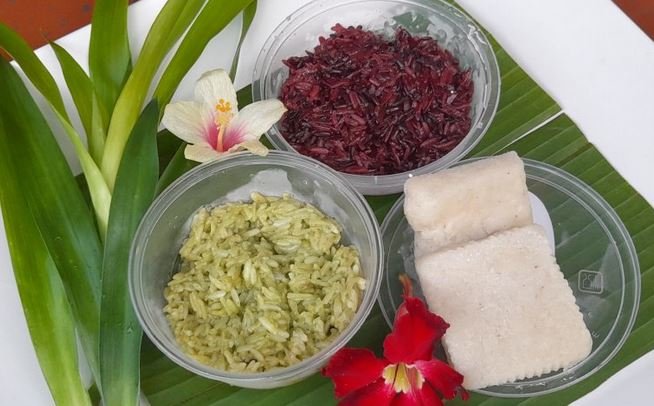
Tape Ketan is a fermented glutinous rice dessert with a sweet and slightly tangy flavor. The fermentation process enhances its aroma and creates a unique taste experience, often enjoyed fresh or mixed with coconut milk.
It’s a traditional treat that represents the art of fermentation in Balinese cuisine.
| About Tape Ketan – Fermented Sweet Rice |
| Highlight: Tape Ketan is a traditional Indonesian fermented snack made from glutinous rice. The fermentation process gives it a sweet, slightly alcoholic flavor and a soft, sticky texture. It’s often enjoyed as a dessert or used in various Indonesian dishes. |
| Main Ingredients: Glutinous rice, yeast (ragi tape), sugar (optional). |
| Taste: Sweet, tangy with a mild alcoholic aroma due to fermentation. |
| Texture: Soft, sticky, slightly chewy. |
| Origin: Widely popular across Indonesia, especially Java and Bali. |
| Best Time to Eat: As a snack or dessert, often eaten fresh after fermentation. |
| Price Range: Around Rp5,000 to Rp15,000 per portion depending on vendor and location. |
| Where to Buy: |
- Traditional markets throughout Indonesia
- Street food vendors selling fermented snacks
- Local warungs and food stalls |
| Serving Suggestion: Serve chilled or at room temperature. Can be eaten alone or used as an ingredient in cakes and desserts. |
Rujak Kuah Pindang – Sweet and Spicy Fruit Salad 🥭🌶️
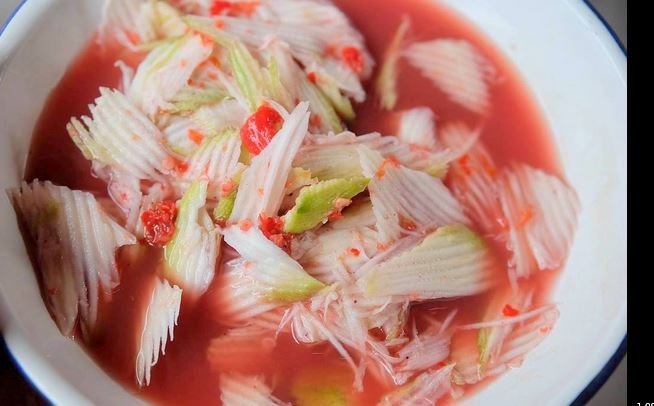
Though not a typical dessert, Rujak Kuah Pindang is a popular Balinese fruit salad with a sweet, sour, and spicy tamarind sauce. Made with tropical fruits like mango, pineapple, and cucumber, it’s a refreshing palate cleanser after a heavy meal.
Its balance of sweet, sour, and spicy flavors embodies the complexity of Balinese taste.
| About Rujak Kuah Pindang – Sweet and Spicy Fruit Salad |
| Highlight: Rujak Kuah Pindang is a traditional Indonesian fruit salad featuring a mix of fresh tropical fruits served with a spicy, tangy, and sweet sauce made from tamarind, palm sugar, chili, and fish broth (kuah pindang). It offers a unique balance of flavors—sweet, sour, salty, and spicy. |
| Main Ingredients: Various tropical fruits (mango, pineapple, cucumber, jicama, etc.), tamarind paste, palm sugar, chili peppers, kuah pindang (fish broth), salt. |
| Taste: A vibrant blend of sweet, spicy, sour, and salty flavors. |
| Texture: Crisp and juicy fruits combined with a thick, flavorful sauce. |
| Origin: Popular traditional snack across Bali and Java regions. |
| Best Time to Eat: Ideal as a refreshing snack or appetizer, especially on hot days. |
| Price Range: Around Rp5,000 to Rp15,000 per serving depending on vendor and fruit variety. |
| Where to Buy: |
- Traditional markets and street food vendors in Bali and Java
- Local warungs and food stalls
- Some Indonesian restaurants specializing in traditional cuisine |
Serving Suggestion: Serve chilled or at room temperature. Mix well before eating to enjoy the full flavor.

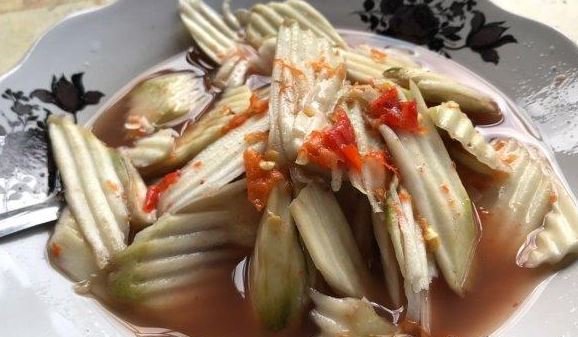
🌶️🥭 How to Make Rujak Kuah Pindang – Sweet and Spicy Fruit Salad
🛒 Ingredients:
For the fruit salad:
- 1 young mango (semi-ripe or sour), sliced thin
- 1/2 pineapple, peeled and sliced thin
- 1 jicama or cucumber, peeled and sliced
- Green guava or kedondong (optional), thinly sliced
For the kuah pindang (spiced fish broth dressing):
- 300 ml water
- 1 small piece of tuna, mackerel, or sardine (boneless)
- 1–2 bird’s eye chilies (adjust to spice level)
- 1 teaspoon shrimp paste (terasi), toasted
- 1 tablespoon palm sugar
- 1 teaspoon tamarind paste
- Salt to taste
- 1 kaffir lime leaf (optional)
🍲 Instructions:
1. Make the kuah pindang (broth):
- Boil the water and add the fish. Let it cook until the fish is soft and flakes apart (about 10–15 minutes).
- Remove the fish, strain the broth if needed, and set aside the clear liquid.
2. Blend or pound the flavor base:
- Using a mortar & pestle or blender, grind the chilies, toasted shrimp paste, palm sugar, tamarind paste, and a pinch of salt into a fine paste.
3. Mix the broth:
- Add the spice paste into the warm fish broth and stir until fully combined.
- Add the kaffir lime leaf (optional) and taste—adjust salt, sugar, or tamarind for balance.
- Let the broth cool completely before using.
4. Assemble the salad:
- In a bowl, combine all the sliced fruit.
- Pour the cooled spicy-sour broth over the fruit and toss well.
✅ Tips:
- Chill the rujak for 15–30 minutes before serving for extra refreshment.
- The flavor is best when the fruit is slightly underripe and crisp.
- Can be made vegetarian by omitting the fish and using mushroom broth or plain water instead.
Jaja Pukis – Fluffy Balinese Cakes 🧁✨

Jaja Pukis are fluffy, sweet cakes made from rice flour and coconut milk, cooked in special molds that give them a unique shape. They’re soft, moist, and often topped with cheese or chocolate for a modern twist.
Popular as a street snack, Jaja Pukis showcases Bali’s fusion of tradition and innovation.
| About Jaja Pukis – Fluffy Balinese Cakes |
| Highlight: Jaja Pukis are traditional Balinese fluffy cakes made from a batter of flour, coconut milk, sugar, and yeast, cooked in a special mold to create a soft, airy texture with a slightly crispy edge. They are often topped with grated coconut or chocolate sprinkles. |
| Main Ingredients: Wheat flour, coconut milk, sugar, yeast, grated coconut, optional toppings like chocolate sprinkles or cheese. |
| Taste: Sweet, rich coconut flavor with a soft and airy texture. |
| Texture: Fluffy and light inside with a slightly crisp outside. |
| Origin: Popular traditional snack across Bali and Indonesia, commonly sold in markets and street stalls. |
| Best Time to Eat: Perfect for breakfast, snack, or dessert. |
| Price Range: Around Rp3,000 to Rp10,000 per piece depending on vendor and toppings. |
| Where to Buy: |
- Traditional markets and street vendors in Bali
- Local warungs and snack stalls
- Indonesian specialty cake shops |
Serving Suggestion: Serve warm, optionally topped with grated coconut or your favorite toppings.
🍰 How to Make Jaja Pukis – Fluffy Balinese Cakes
🛒 Ingredients:
- 250 grams all-purpose flour
- 150 grams sugar
- 2 eggs
- 1 teaspoon instant yeast
- 1/2 teaspoon salt
- 350 ml coconut milk (warm, not hot)
- 1 teaspoon vanilla extract (optional)
- Butter or oil for greasing
- Optional toppings: grated cheese, chocolate sprinkles, pandan paste, or condensed milk
🥄 Instructions:
1. Make the batter:
- In a large mixing bowl, whisk the eggs and sugar until light and slightly foamy.
- In a separate bowl, mix flour, yeast, and salt.
- Gradually add the flour mixture to the egg mixture while alternating with warm coconut milk. Mix until smooth and lump-free.
- Add vanilla extract if using.
- Cover the bowl and let the batter rest for 30–45 minutes until it rises and becomes bubbly.
2. Prepare the mold:
- Heat a special pukis mold (like a half-moon or oval pan) or use a muffin pan as an alternative.
- Lightly grease each cavity with butter or oil.
3. Cook the Pukis:
- Pour the batter into each cavity about 3/4 full.
- Add toppings like grated cheese or chocolate sprinkles if desired.
- Cover the pan (or use a lid if using a nontraditional mold) and cook on low-medium heat for 5–7 minutes or until the top is set and the bottom is golden.
- No need to flip.
4. Serve:
- Remove the cakes from the mold and serve warm or at room temperature.
Tipat Cantok – Traditional Balinese Rice Cake with Spicy Peanut Sauce 🍛🥜
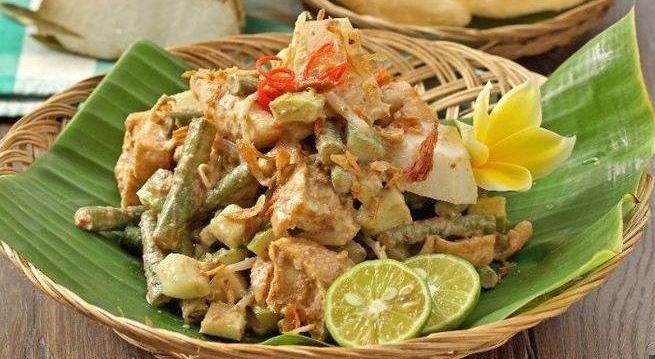
Tipat Cantok is a classic Balinese dish that combines simple, fresh ingredients with a flavorful peanut sauce. This beloved local specialty features steamed rice cakes called tipat (or ketupat) served alongside boiled vegetables such as spinach, bean sprouts, and long beans. The key highlight is the cantok—a rich, spicy peanut sauce made from ground peanuts, chili, garlic, and aromatic spices.
Why You Should Try It
Tipat Cantok is a popular street food in Bali, cherished for its balance of savory, spicy, and nutty flavors. It’s a healthy and satisfying vegetarian meal that offers a taste of authentic Balinese cuisine.
About Tipat Cantok
- Main Ingredients: Steamed rice cakes (ketupat), boiled spinach, bean sprouts, long beans, spicy peanut sauce, fried shallots, with optional additions like tempeh or tofu.
- Taste: A delicious combination of savory, slightly spicy, and nutty flavors with the freshness of vegetables.
- Texture: Soft rice cake paired with crunchy vegetables, all coated in creamy peanut sauce.
- Origin: A traditional dish from Bali, Indonesia, commonly found in local markets and warungs.
- Best Time to Eat: Ideal for lunch or dinner when you want something light yet filling.
- Price Range: Usually around Rp10,000 to Rp25,000 per serving depending on location and extras.
- Where to Find It: Street vendors, traditional markets, small local eateries (warungs) in Bali, and some Indonesian restaurants abroad.
Serving Tip: Serve Tipat Cantok warm or at room temperature, topped with crispy fried shallots. Pair it with tempeh or tofu to boost protein and add extra texture.
Sure! Here’s a clear and easy How to Make Tipat Cantok guide in English:
How to Make Tipat Cantok – Traditional Balinese Rice Cake with Spicy Peanut Sauce
Ingredients:
- 2 cups steamed rice cakes (tipat or ketupat), cut into bite-sized pieces
- 1 cup boiled spinach, chopped
- 1 cup boiled bean sprouts
- 1 cup boiled long beans, cut into 2-inch pieces
- 1/2 cup fried shallots (optional)
For the Peanut Sauce (Cantok):
- 1 cup roasted peanuts
- 3 cloves garlic
- 2 red chilies (adjust to taste)
- 1 teaspoon palm sugar (or brown sugar)
- 1 tablespoon tamarind paste or juice of 1 lime
- Salt to taste
- Water (to thin the sauce as needed)
Optional:
- Fried tofu or tempeh, cut into cubes
Instructions:
- Prepare the Peanut Sauce:
- Grind roasted peanuts, garlic, and red chilies together using a mortar and pestle or food processor until smooth.
- Add palm sugar, tamarind paste (or lime juice), and salt. Mix well.
- Slowly add water little by little to reach a smooth, pourable sauce consistency. Set aside.
- Prepare the Vegetables and Rice Cake:
- Boil spinach, bean sprouts, and long beans separately until tender but still crisp. Drain and set aside.
- Cut steamed rice cakes into bite-sized pieces.
- Assemble the Dish:
- In a large bowl, combine the rice cakes and boiled vegetables.
- Pour the peanut sauce over the mixture and toss gently until everything is coated evenly.
- Serve:
- Transfer to a serving plate.
- Sprinkle with fried shallots for added crunch and aroma.
- Add fried tofu or tempeh on the side if desired.
Tips:
- Adjust the spiciness of the peanut sauce by adding more or fewer chilies.
- You can substitute palm sugar with brown sugar or honey.
- Serve Tipat Cantok warm or at room temperature for the best flavor.
Why Traditional Balinese Desserts Matter 🌺❤️
Balinese desserts are more than just sweet treats — they are an expression of cultural identity, spiritual beliefs, and local ecology. The ingredients often come from the island’s rich environment, including rice, coconut, palm sugar, and tropical fruits. Many desserts are intertwined with religious ceremonies and rituals, symbolizing offerings and gratitude.
Enjoying these desserts offers a glimpse into Balinese life, blending hospitality, artistry, and nature.
Tips for Trying Balinese Desserts 🍽️✨
- Visit local markets: They’re the best places to find authentic traditional desserts.
- Ask locals: Learn the stories behind each dessert for a richer experience.
- Try fresh: Many desserts taste best fresh-made or slightly warm.
- Balance flavors: Don’t shy away from mixing sweet, salty, and spicy in your tasting journey.
- Respect customs: Some desserts are meant for religious offerings and might not be for sale.
Conclusion 🌅🍨
If you think Bali is just about beaches and sunsets, think again. The island’s traditional desserts offer a sweet, flavorful adventure that deserves a spot on every traveler’s itinerary. From the chewy Klepon bursting with palm sugar to the refreshing Es Campur perfect for a hot day, these desserts are a testament to Bali’s rich cultural tapestry and culinary heritage.
Next time you visit Bali, or if you’re looking to explore something new in the world of sweets, dive into these traditional Balinese desserts. They’re not just food—they’re stories, history, and culture on a plate.

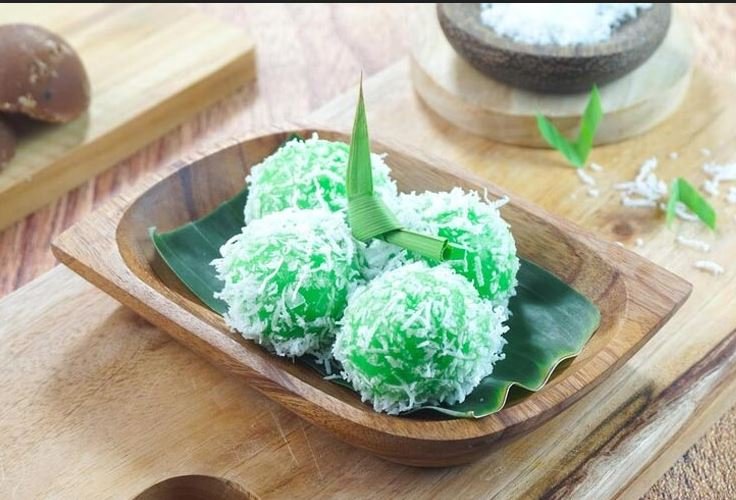



























Join The Discussion